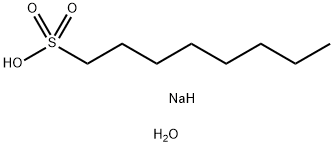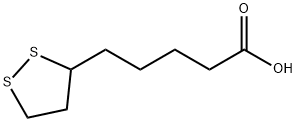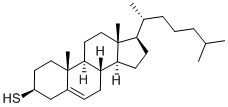1-Heptanethiol
Synonym(s):1-Heptanethiol;Heptyl mercaptan;Mercaptan C7
- CAS NO.:1639-09-4
- Empirical Formula: C7H16S
- Molecular Weight: 132.27
- MDL number: MFCD00004911
- EINECS: 216-678-8
- SAFETY DATA SHEET (SDS)
- Update Date: 2024-12-18 14:08:52

What is 1-Heptanethiol?
Description
1-Heptanethiol is a flammable, colorless liquidwith a strong odor. Molecular weight= 132.29; Boilingpoint= 176℃; Freezing/Melting point= -439C; Flashpoint = 46℃. Insoluble in water.
Chemical properties
clear liquid
Chemical properties
1-Heptanethiol is a flammable, colorless liquid with a strong odor.
Chemical properties
Colorless liquid, onion aroma.
What are the applications of Application
1-Heptanethiol is used in the study of self-assembled monolayers
Definition
ChEBI: Heptane-1-thiol is an alkanethiol.
Aroma threshold values
High strength odor, sulfurous onion type; recommend smelling in a 0.10% solution or less.
General Description
Colorless liquid with a strong unpleasant odor. Mp: -41.3°C; bp: 177°C. Density: 0.84 g cm-3. Insoluble in water.
Reactivity Profile
1-Heptanethiol is combustible (flash point at or above 100°F and below140°F). Incompatible with oxidizing agents, strong acids and strong bases, alkali metals, and nitric acid. Can react with water, steam or acids to produce toxic and flammable vapors. Reacts violently with powerful oxidizing agents such as calcium hypochlorite(Ca(OCl)2) to generate SOx. Reacts with hydrides to form flammable H2 gas; reacts with halogenated hydrocarbons to yield HX. Reacts exothermically with aldehydes. Emits toxic compounds of sulfur when when heated to decomposition.
Potential Exposure
Used as a chemical intermediate for fuels, dyes, pharmaceuticals; and to make other chemicals.
First aid
If this chemical gets into the eyes, remove anycontact lenses at once and irrigate immediately for at least 15 min, occasionally lifting upper and lower lids. Seek med-ical attention immediately. If this chemical contacts theskin, remove contaminated clothing and wash immediatelywith soap and water. Seek medical attention immediately. Ifthis chemical has been inhaled, remove from exposure,begin rescue breathing (using universal precautions, includ-ing resuscitation mask) if breathing has stopped and CPR ifheart action has stopped. Transfer promptly to a medicalfacility. When this chemical has been swallowed, get medi-cal attention. Give large quantities of water and induce :vomiting. Do not make an unconscious person vomit.
storage
Color Code- Red: Flammability Hazard: Store ina flammable liquid storage area or approved cabinet away from ignition sources and corrosive and reactive materials.Prior to working with this chemical you should be trainedon its proper handling and storage. Store in tightly closedcontainers in a cool, well-ventilated area. Metal containersinvolving the transfer of this chemical should be groundedand bonded. Where possible, automatically pump liquidfrom drums or other storage containers to process contain-ers. Drums must be equipped with self-closing valves,pressure vacuum bungs, and flame arresters. Use only non-sparking tools and equipment, especially when opening andclosing containers of this chemical. Sources of ignition,such as smoking and open flames, are prohibited where thischemical is used, handled, or stored in a manner that couldcreate a potential fire or explosion hazard. W herever thischemical is used, handled, manufactured, or stored, useexplosion-proof electrical equipment and fittings.
Shipping
UN1228 Mercaptans, liquid, flammable, toxic, n.o.s. or Mercaptan mixtures, liquid, flammable, toxic, n.o.s., Hazard Class: 3; Labels: 3-Flammable liquid, 6.1-Poisonous materials, Technical Name Required.
Incompatibilities
Incompatible with oxidizers (chlorates, nitrates, peroxides, permanganates, perchlorates, chlorine, bromine, fluorine, etc.); contact may cause fires or explo sions. Keep away from alkaline materials, strong bases, strong acids, oxoacids, epoxides, alkali metals and reducing agents.
Waste Disposal
Dissolve or mix the material with a combustible solvent and burn in a chemical incinera tor equipped with an afterburner and scrubber. All federal, state, and local environmental regulations must be observed.
Properties of 1-Heptanethiol
| Melting point: | -43°C |
| Boiling point: | 173-176 °C/765 mmHg (lit.) |
| Density | 0.844 g/mL at 25 °C (lit.) |
| refractive index | n |
| FEMA | 4259 | HEPTANE-1-THIOL |
| Flash point: | 115 °F |
| storage temp. | Store below +30°C. |
| solubility | 0.009g/l |
| form | clear liquid |
| pka | 10.76±0.25(Predicted) |
| color | Colorless to Almost colorless |
| Odor | at 0.10 % in propylene glycol. sulfurous onion |
| explosive limit | 0.9%(V) |
| Sensitive | Air Sensitive |
| JECFA Number | 1663 |
| BRN | 1731687 |
| Exposure limits | NIOSH: Ceiling 0.5 ppm(2.7 mg/m3) |
| CAS DataBase Reference | 1639-09-4(CAS DataBase Reference) |
| NIST Chemistry Reference | 1-Heptanethiol(1639-09-4) |
| EPA Substance Registry System | 1-Heptanethiol (1639-09-4) |
Safety information for 1-Heptanethiol
| Signal word | Warning |
| Pictogram(s) |
 Flame Flammables GHS02 |
| GHS Hazard Statements |
H226:Flammable liquids |
| Precautionary Statement Codes |
P210:Keep away from heat/sparks/open flames/hot surfaces. — No smoking. P233:Keep container tightly closed. P240:Ground/bond container and receiving equipment. P241:Use explosion-proof electrical/ventilating/lighting/…/equipment. P242:Use only non-sparking tools. P243:Take precautionary measures against static discharge. |
Computed Descriptors for 1-Heptanethiol
New Products
4-Fluorophenylacetic acid 4-Methylphenylacetic acid N-Boc-D-alaninol N-BOC-D/L-ALANINOL Tert-butyl bis(2-chloroethyl)carbamate 3-Morpholino-1-(4-nitrophenyl)-5,6-dihydropyridin- 2(1H)-one Furan-2,5-Dicarboxylic Acid Tropic acid S-2-CHLORO PROPIONIC ACID ETHYL ISOCYANOACETATE 2-Bromo-1,3-Bis(Dimethylamino)Trimethinium Hexafluorophosphate (6-METHYL-[1,3]DITHIOLO[4,5-b]QUINOXALIN-2-ONE INDAZOLE-3-CARBOXYLIC ACID 4-IODO BENZOIC ACID (2-Hydroxyphenyl)acetonitrile 4-Bromopyrazole 5,6-Dimethoxyindanone 2-(Cyanocyclohexyl)acetic acid 4-methoxy-3,5-dinitropyridine 2-aminopropyl benzoate hydrochloride 1-(4-(aminomethyl)benzyl)urea hydrochloride diethyl 2-(2-((tertbutoxycarbonyl)amino) ethyl)malonate tert-butyl 4- (ureidomethyl)benzylcarbamate Ethyl-2-chloro((4-methoxyphenyl)hydrazono)acetateRelated products of tetrahydrofuran








You may like
-
 1-Heptanethiol CAS 1639-09-4View Details
1-Heptanethiol CAS 1639-09-4View Details
1639-09-4 -
 1-Heptanethiol CAS 1639-09-4View Details
1-Heptanethiol CAS 1639-09-4View Details
1639-09-4 -
 1-Heptanethiol CAS 1639-09-4View Details
1-Heptanethiol CAS 1639-09-4View Details
1639-09-4 -
 1975-50-4 98%View Details
1975-50-4 98%View Details
1975-50-4 -
 2-HYDROXY BENZYL ALCOHOL 98%View Details
2-HYDROXY BENZYL ALCOHOL 98%View Details
90-01-7 -
 2-Chloro-1,3-Bis(Dimethylamino)Trimethinium Hexafluorophosphate 221615-75-4 98%View Details
2-Chloro-1,3-Bis(Dimethylamino)Trimethinium Hexafluorophosphate 221615-75-4 98%View Details
221615-75-4 -
 14714-50-2 (2-Hydroxyphenyl)acetonitrile 98+View Details
14714-50-2 (2-Hydroxyphenyl)acetonitrile 98+View Details
14714-50-2 -
 118753-70-1 98+View Details
118753-70-1 98+View Details
118753-70-1